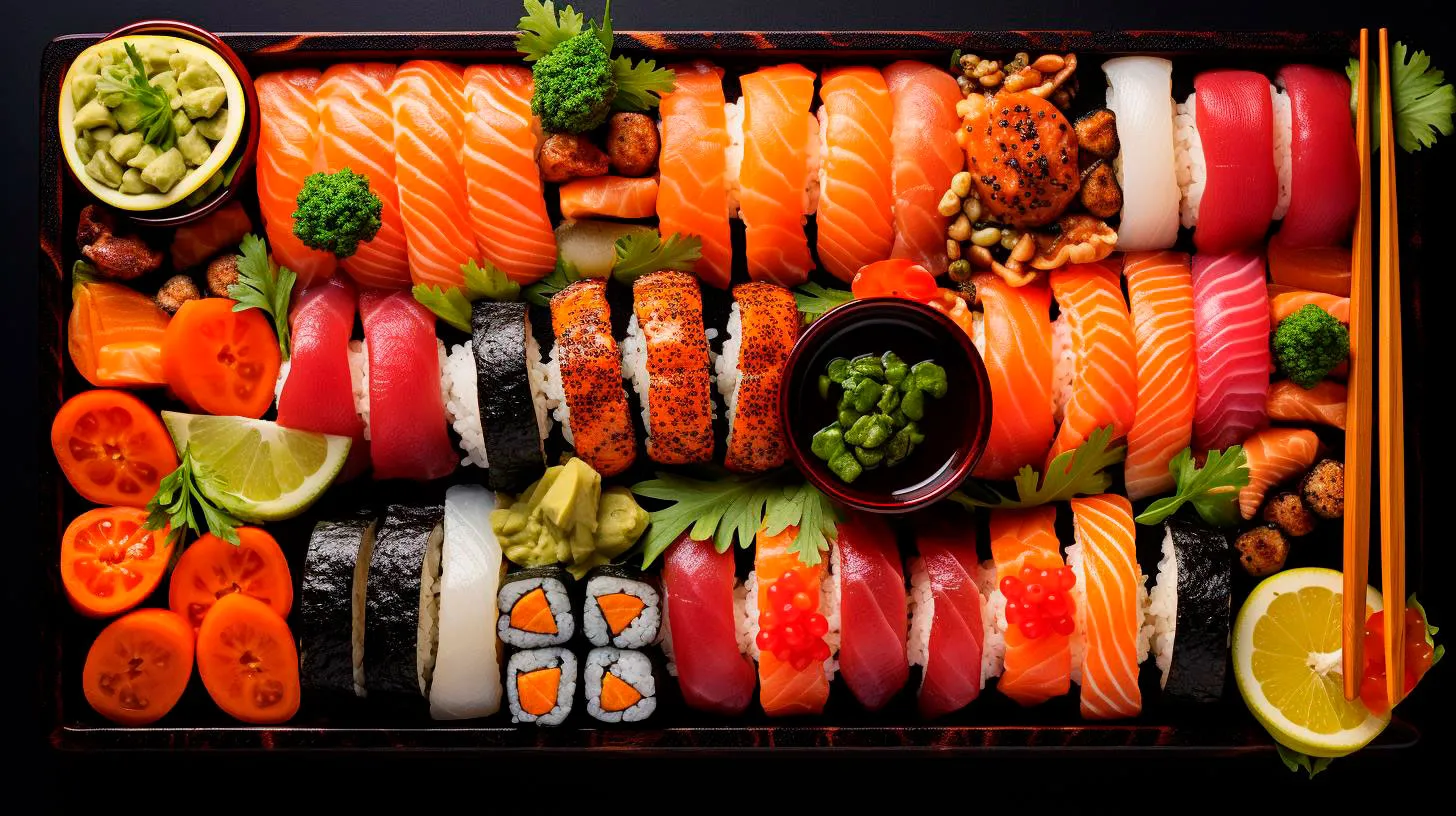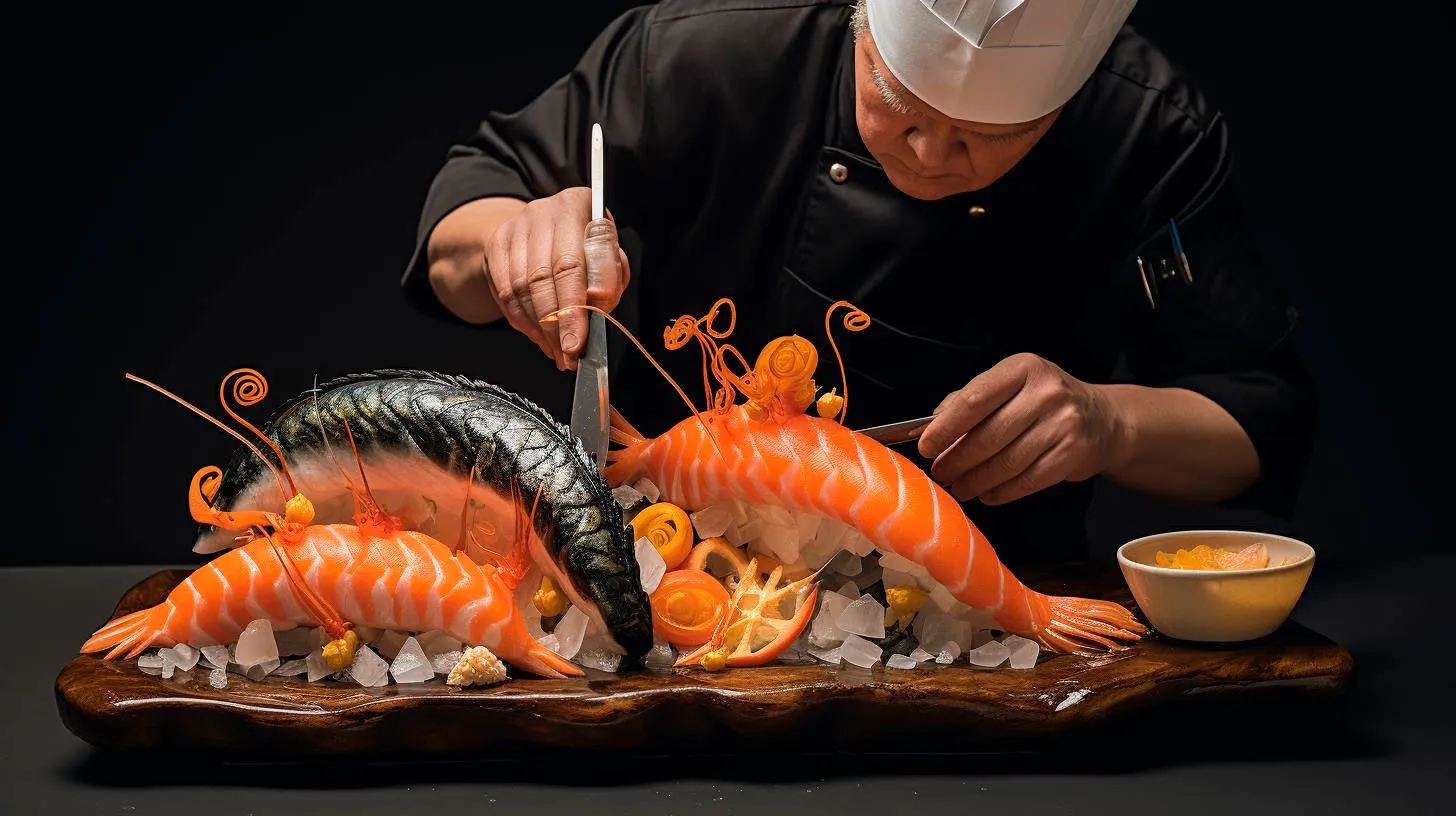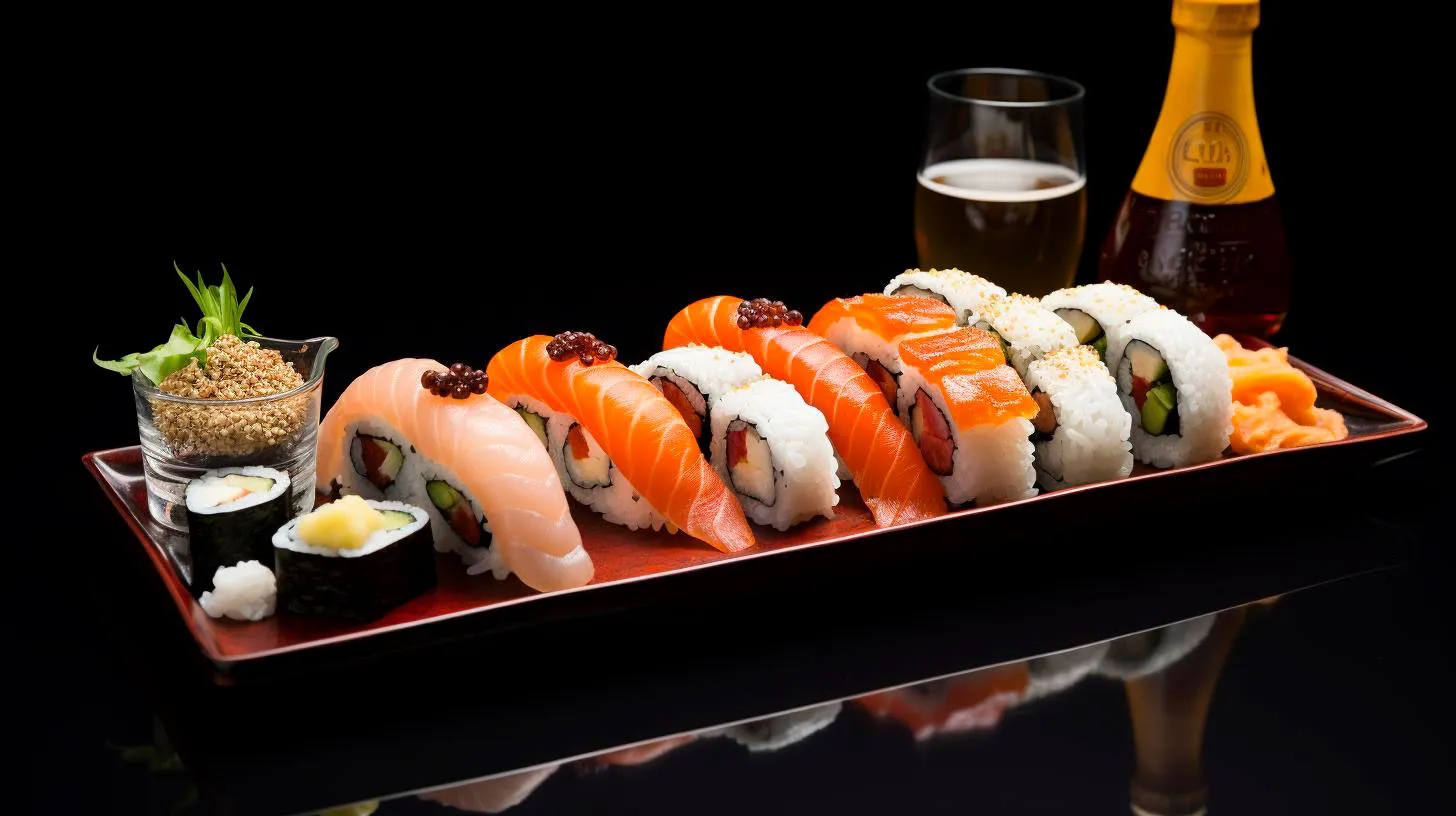Unlocking the Secrets of Sushi Knife Mastery and Roll Creation
The Key to Sushi Knife Mastery
When it comes to sushi knife mastery, there are a few key factors that come into play. First and foremost, you need to invest in a high-quality sushi knife. Japanese sushi knives, in particular, are known for their exceptional craftsmanship and precision. Look for a knife with a sharp, thin blade made from high-carbon steel, as this will allow for precise cuts and smooth slicing. Additionally, a quality sushi knife should have a comfortable handle that allows for a firm grip, ensuring safety and control.
Once you have your sushi knife, it’s important to learn the proper cutting techniques. Here are a few key techniques that every sushi chef should master:
- Slice: The slice is the most basic and crucial technique for any sushi chef. Start by gripping the handle firmly and using a smooth, steady motion to cut through the fish. The blade should move in a forward/backward motion rather than up and down to ensure clean and even cuts.
- Dice: Dicing is essential for creating small, bite-sized pieces of fish for nigiri or sashimi. Hold the fish firmly and slice across the grain in one direction, then turn the fish 90 degrees and make additional slices to create uniform cubes.
- Chop: Chopping is used for ingredients like vegetables and herbs. Hold the knife’s handle with one hand and place the other hand on top of the blade to guide the motion. Use a rocking motion to cut through the ingredients quickly and efficiently.
By mastering these techniques, you’ll be able to slice and dice with precision, ensuring that every piece of sushi you create is a work of art.
Roll Creation: Unleash Your Creativity
Sushi rolls are not only delicious but also offer endless possibilities for creativity. However, creating the perfect roll requires more than just mixing ingredients together. Here are some key tips for mastering the art of sushi roll creation:
- Choose the Right Rice: The rice is the foundation of any sushi roll. Use short-grain sushi rice and follow proper preparation techniques, including rinsing and cooking with the right amount of water. The rice should be sticky enough to hold the roll together but not too sticky that it becomes difficult to work with.
- Add Variety: Don’t be afraid to experiment with different fillings and ingredients. Mix and match flavors and textures to create unique and exciting combinations. From fresh seafood to crunchy vegetables, the possibilities are endless.
- Perfect Your Rolling Technique: Rolling sushi may seem daunting at first, but with practice, you’ll get the hang of it. Start by placing a sheet of nori (seaweed) on a bamboo sushi mat, then add a thin layer of rice and your desired fillings. Use the bamboo mat to tightly roll the sushi, applying gentle pressure to ensure it holds its shape.
Remember, practice makes perfect. Keep experimenting with different combinations and techniques to find your own signature roll.
The Advantages of Sushi Knife Mastery
Becoming a master of sushi knife techniques and roll creation offers numerous advantages:
- Precision and Consistency: Mastering the art of sushi knife techniques allows you to create precise and consistent cuts, ensuring that each piece of sushi is visually appealing and enjoyable.
- Enhanced Safety: Proper knife techniques not only enable better control but also reduce the risk of accidents in the kitchen.
- Creative Freedom: With a mastery of sushi roll creation, you can unleash your creativity and experiment with different flavor combinations, making each roll a unique culinary experience.
- Professional Potential: Becoming skilled in sushi knife mastery and roll creation can open doors to opportunities in the culinary industry. Whether you dream of becoming a sushi chef or simply want to impress your friends and family, these skills will set you apart.
Key Takeaways
Unlocking the secrets of sushi knife mastery and roll creation requires practice, dedication, and the right tools. Remember these key takeaways as you embark on your journey:
- Invest in a high-quality sushi knife made from high-carbon steel for precision cutting.
- Master essential cutting techniques, including slicing, dicing, and chopping.
- Choose the right type of rice and experiment with various fillings to unleash your creativity.
- Practice your rolling technique for perfectly shaped rolls.
- Enjoy the advantages of precision, consistency, safety, creativity, and professional potential that come with mastering sushi knife techniques and roll creation.
With enough practice and a passion for sushi, you’ll be well on your way to becoming a sushi master in no time!
The Art of Knife Techniques in Sushi Roll Crafting
In this article, we will delve into the world of knife techniques in sushi roll crafting, exploring the various methods and their impact on the final result.
The Importance of Knife Techniques
When it comes to sushi, presentation is key. The way the ingredients are sliced and arranged can elevate or diminish the overall aesthetic appeal of the dish. Knife techniques play a crucial role in achieving the desired textures, shapes, and sizes, ultimately enhancing the visual appeal and taste experience.
Moreover, the precision of knife techniques affects the texture of the ingredients. For example, slicing fish against the grain can make it more tender and enhance its flavor. By adjusting the angle and pressure of the knife, sushi chefs can manipulate the texture and create unique mouthfeel sensations.
Essential Knife Techniques in Sushi Roll Crafting
1. Usu-Zukuri – Thin Slices: This technique involves cutting the ingredients into thin, translucent slices. Usu-zukuri is commonly used for delicate fish like whitefish, to highlight its natural beauty and delicate texture. With a sharp knife and steady hand, chefs can achieve paper-thin slices that simply melt in your mouth.
2. Kaku-Zukuri – Square Slices: Kaku-zukuri refers to cutting ingredients into uniformly square-shaped slices. This technique is often used for vegetables like cucumbers and carrots, ensuring they fit perfectly into the sushi rolls. The even cuts provide an appealing visual pattern and allow for consistent flavors in each bite.
3. Hira-Zukuri – Flat Slices: Hira-zukuri involves creating flat slices that are wider than they are tall. This technique is particularly important when preparing fish for nigiri sushi. The slices should be proportional and consistent, offering a balance of flavors and textures in every bite.
4. Tataki-Zukuri – Minced Ingredients: Tataki-zukuri is a technique that involves mincing the ingredients, such as fish or vegetables, into fine pieces. This method is commonly used for creating fillings and garnishes for sushi rolls. The small, uniform cuts ensure an even distribution of flavors throughout the roll.
Mastering Knife Techniques: Advantages and Key Takeaways
1. Consistent Presentation: By mastering knife techniques, sushi chefs can achieve consistent and visually appealing sushi rolls. Uniform slices and cuts add a professional touch to the final presentation.
- Proper knife techniques ensure sushi rolls with an aesthetically pleasing appearance.
- Consistent slices and shapes provide an elegant and professional look to your creations.
2. Enhanced Texture and Flavor: Knife techniques allow chefs to control the texture and flavor of the ingredients, resulting in a more enjoyable sushi experience.
- Various knife techniques can influence the texture of the ingredients, offering different mouthfeel experiences.
- Carefully cut ingredients release their flavors more effectively, enhancing the overall taste of the sushi rolls.
3. Improved Efficiency: Mastering knife techniques helps sushi chefs work more efficiently, saving time and ensuring consistency.
- Efficient knife skills allow chefs to slice ingredients quickly and accurately, improving productivity in busy sushi kitchens.
- Consistency in cuts ensures that every sushi roll meets the expected quality standards, even during peak hours.
The Fascinating World of Sushi Knife Techniques
Did you know?
- Japanese sushi knives are typically single-edged, enhancing precision and control during slicing.
- The Yanagi knife, a traditional sushi knife, is known for its long, thin blade ideal for making long, clean cuts.
- A sushi chef can spend years perfecting their knife skills to ensure the utmost precision and artistry in sushi roll crafting.
Knife techniques are an integral part of the art of sushi roll crafting. Whether it’s creating thin slices for delicate fish or perfectly square cuts for vegetables, the mastery of knife skills enables sushi chefs to deliver visually stunning and gastronomically delightful sushi rolls. So the next time you enjoy a beautifully prepared sushi roll, take a moment to appreciate the precision and artistry that goes into every knife cut.
Elevating Sushi Making through Precision Knife Handling
Mastering the art of knife work is not only crucial for creating visually appealing sushi, but it also enhances the taste and texture of the final dish. In this article, we will explore the significance of precision knife handling and how it can elevate sushi making to new heights.
The Importance of Precision Knife Handling
Sushi making is an intricate art form that demands precision and attention to detail. Every cut, slice, and chop made during the preparation process directly impacts the final outcome of the sushi. Proper knife handling techniques ensure that the ingredients are cut to the ideal size and shape, allowing flavors to mingle harmoniously and textures to complement each other perfectly. Here are some key factors that make precision knife handling essential in sushi making:
- Consistent Slice Thickness: The thickness of each slice of fish or vegetable plays a crucial role in the overall sushi experience. Precise knife handling ensures that each piece is uniform in size, ensuring a consistent bite and texture.
- Minimal Cell Damage: When ingredients are handled roughly or incorrectly, their cells are damaged, affecting their taste and texture. A skilled sushi chef can minimize cell damage by using proper knife techniques, preserving the integrity of the ingredients.
- Enhanced Presentation: Sushi is not only about taste but also about presentation. Precise knife work allows chefs to create visually appealing sushi, enhancing the overall dining experience for customers.
Mastering Precision Knife Handling Techniques
Knife Selection:
The first step in mastering precision knife handling is choosing the right knife. A sushi chef typically uses a Yanagiba (sashimi knife) for slicing fish and a Deba (fish knife) for heavy-duty tasks such as filleting. These knives have sharp, single-edged blades designed for precise cuts.
Proper Grip:
Having a proper grip on the knife is crucial for precise control. A pinch grip, where the index finger and thumb grip the blade close to the bolster, provides optimal balance and control. This grip allows for smooth and controlled slicing motions while reducing the risk of accidents.
Techniques:
Sushi chefs employ various knife techniques to create different cuts and shapes. Here are a few essential techniques:
- Usuzukuri: This technique involves making paper-thin slices of fish, usually used in sashimi. The thinness of the slices enhances the delicate taste and texture of the fish.
- Katsuramuki: Katsuramuki is the technique of peeling vegetables in a continuous, thin, and wide sheet. This technique not only adds visual appeal to sushi but also ensures even cooking and consistent texture.
- Hirazukuri: This technique involves making thin, rectangular slices by cutting the ingredient parallel to the cutting board. Hirazukuri is often used for ingredients like cucumbers and daikon radish to create decorative garnishes.
Benefits of Precision Knife Handling in Sushi Making
Mastering precision knife handling techniques in sushi making offers several benefits:
- Enhanced Flavor: Precision knife handling techniques ensure that the delicate flavors of the ingredients are preserved, resulting in a superior taste experience for sushi lovers.
- Improved Texture: Proper knife work allows chefs to create consistent and uniform textures in sushi. Each bite becomes a delightful symphony of flavors and textures.
- Efficiency and Speed: With precise knife handling, sushi chefs can work quickly and efficiently, saving time while maintaining quality.
Key Takeaways
Mastering precision knife handling techniques is essential for elevating sushi making to an art form. By paying close attention to the way knives are handled and implementing proper techniques, sushi chefs can enhance the taste, texture, and presentation of their creations. The significance of precision knife handling goes beyond aesthetics; it directly impacts the overall dining experience and leaves customers with unforgettable sushi memories.
Mastering the Perfect Cuts: Knife Skills in Sushi Roll Artistry
A Knife is an Extension of Your Hand
Before diving into the intricacies of knife techniques, it’s crucial to understand that a knife is more than just a tool in the hands of a sushi chef. It is an extension of their hand, enabling them to shape and transform ingredients into edible masterpieces. Here are some key takeaways on the importance of knives in sushi preparation:
- A sharp and well-maintained knife allows for smoother and cleaner cuts, ensuring the integrity and presentation of the sushi rolls.
- A comfortable and properly balanced knife provides better control, reducing the risk of accidents while working with delicate ingredients.
- Investing in high-quality knives is essential for long-term efficiency and precision in sushi-making.
Basic Knife Techniques
Now let’s explore some of the fundamental knife skills that are used extensively in sushi roll artistry:
1. Slicing (Kirisuki)
Slicing refers to cutting ingredients into thin and uniform pieces. This technique is crucial for achieving consistent textures and flavors in sushi rolls. Here are some key points to remember about slicing:
- Use long, sweeping motions across the ingredient to create even slices.
- Maintain a steady hand, applying consistent pressure with each stroke.
- Mastering the slicing technique allows for precise cuts, resulting in visually appealing sushi rolls.
2. Dicing (Katsura-muki)
Dicing involves cutting ingredients into small, uniform squares. This technique is commonly used for vegetables and fillings in sushi rolls. Take note of the following points when dicing:
- Start by cutting the ingredient into thin slices before stacking them and cutting crosswise into little squares.
- Ensure all the diced pieces are of the same size for a more appealing presentation.
- Practice is crucial to achieve consistent and efficient dicing.
3. Filleting (Sogi)
Filleting is the process of removing bones and skin from fish or other ingredients. This technique is essential for sushi chefs to work with fish and create sashimi. Here are some important tips for filleting:
- Use a sharp, flexible knife to efficiently separate the flesh from the bones.
- Maintain a steady grip to prevent damage to the delicate fillets.
- Precision is key to achieve clean fillets and maximize the yield of usable ingredients.
Advantages of Mastering Knife Skills in Sushi Artistry
Mastering knife skills in sushi roll artistry offers numerous advantages to both professional chefs and home cooks:
- Enhanced efficiency and speed in ingredient preparation, allowing chefs to handle a higher volume of orders.
- Improved presentation with visually appealing and uniform cuts in sushi rolls.
- Better control over ingredient textures, resulting in a more satisfying dining experience.
- Minimized risk of accidents or injuries while working with sharp knives.
Key Takeaways for Mastering Knife Skills in Sushi Artistry
Here are the key takeaways to keep in mind as you embark on your journey to master knife skills in sushi artistry:
- A sharp and well-maintained knife is essential for clean, precise cuts.
- Practice fundamental techniques like slicing, dicing, and filleting to achieve consistent results.
- Invest in high-quality knives that suit your needs and preferences.
- Mastering knife skills will enhance your efficiency, presentation, and overall sushi-making experience.
Sushi roll artistry is not just about the ingredients; it’s about the passion and dedication sushi chefs infuse into each cut. By mastering knife skills, you can elevate your sushi-making to an art form that leaves a lasting impression on anyone lucky enough to savor your creations.


